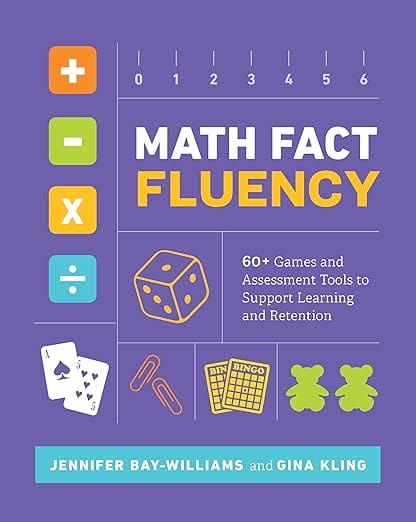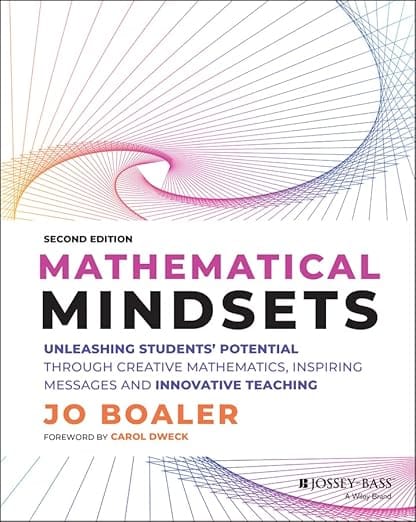Math Fact Fluency: But What Exactly Is It?
Have you ever heard an adult saying "I'm just not a Math Person"? They may be successful in so many other ways, and might even show great ability and intelligence in other areas; but they still can't get over Math. For a long time, I wondered why this happened.
Turned out the roots of this generally went back to their childhood days - kids who intuitively learnt more efficient strategies were labelled "good at Math". And Kids who stuck to the standard method, or were using less efficient methods, were labelled "bad at Math". Traditional Math teaching never focused on explicit Math Facts Strategy instruction; kids who developed Math fact fluency developed this despite the poor instruction, not because of it.
So what exactly is this Math Fact Fluency? And more importantly, what is it not? How to build it in our kids? Let's find out more.
What is Math Fact Fluency?
Math fact fluency is the ability to quickly recall basic math facts in addition, subtraction, multiplication, and division without conscious effort. It goes beyond simple memorization - students need to understand the operations and apply strategies flexibly. Students who have developed math fact strategies can typically give correct answers within two seconds, pulling the information directly from long-term memory rather than counting or using other time-consuming methods.
Math Fact Fluency has 3 distinct components -
- Flexibility - ability to arrive at the answer for an expression in different ways
- Efficiency - ability to choose a faster approach to finding the answer rather than a less efficient one
- Accuracy - How accurate is the final answer arrived at by the learner.
A combination of skilling up on all these 3 components leads to automaticity.
Math Fact fluency is not just the ability to regurgitate math facts that were rote-learnt. For e.g. a child might know tables of 1 to 12 cold - she still might not be fluent in Math because she doesn't understand how it works. If she forgets for a moment what is 5X6, but remembers 5X5 = 25 - can she derive 5X6 from that? Or does she have to start reciting the tables again from 5X1, 5X2, etc? That is what differentiates true Math fact fluency vs. just rote memorisation.
Why Is Math Fact Fluency Important for K–3 Learners?
When students master basic math facts, they free up mental space for tackling more complex math problems. This skill acts as a building block for future mathematical success. Students who can quickly recall math facts show better performance on standardized tests and excel at mathematical reasoning.
Strong math fact fluency also helps build student confidence. Children who can answer basic math questions without hesitation tend to develop positive attitudes toward mathematics, making them more willing to take on new challenges.
Old vs. New: Teaching Math Facts Effectively
Past teaching methods relied heavily on rote memorization and repetitive drills to build math fact knowledge. Today's approaches focus on helping students grasp develop the Math understanding first. Teachers now incorporate tools like arithmetic racks, dominoes, and number lines to support learning.
Modern methods blend strategy instruction with practice time. Students learn techniques like "doubles plus 1" and "making tens" to build number sense. This balanced approach helps students develop both speed and understanding.
There are several researchers who have advanced the state of the art in Math Fact instructions. Some of them are -
Dr. Jennifer Bay-Williams - Author of Math Fact Fluency Book
Math education expert Jennifer Bay-Williams promotes a strategy-based method for teaching basic math facts.

Her research shows that combining targeted strategy instruction with regular practice leads to better retention. She recommends using games, activities, and daily assessment to track student progress. Her methods focus on building connections between math facts rather than isolated memorization, helping students make sense of number relationships.
Monster Math is based on Dr. Bay-William's work and focuses on helping kids learn different strategies that can build Math Fact fluency.
Cathy William's Number Talks
Cathy promotes "Math Talks" or "Number Talks" technique for teachers and parents to help kids develop Math fact Fluency.
Math Talks promote fact fluency through guided classroom discussions where students share their mental math strategies. During these brief, daily sessions, students explain their thinking processes out loud, helping others understand different ways to solve problems.
Students learn from hearing their peers' methods and develop confidence in expressing mathematical ideas. The verbal practice strengthens memory pathways and builds number sense skills.
Here's a quick video from Dr. Jo Boaler explaining this (and we cover her work too below) -
Dr. Jo Boaler's Research on Math Anxiety and Fact Fluency
Stanford Professor Jo Boaler's work shows that timed tests and speed-focused practice can increase math anxiety in students. Her research indicates that stress blocks working memory, making it harder for children to recall basic math facts.
She suggests replacing timed drills with number talks and pattern-based activities. Students learn math facts better when they work at their own pace and make number connections through games and visual models. A lot of her work focuses on making Math more visual and helping kids.
Her books Mathematical Mindsets and MATH-ish are excellent reads. She especially suggests that higher Math is creative in nature, and understanding the creativity in Math can inspire young learners to find new interest in the subject or understand it better than by just rote learning.

Read more about how ADHD affects math learning in this article.
Parent Strategies to Build Math Fact Fluency at Home
Parents can make math practice enjoyable through simple games and activities. Card games, board games, and dice activities offer repeated chances to work with numbers while having fun. During car rides or meal prep, parents can ask quick mental math questions to get more practice.
However instead of only focusing on speed and accuracy, also ask them "How did you do it?" And if they say something like "I just knew it" - dig deeper.
Daily activities like grocery shopping or cooking present natural opportunities to practice math facts. Counting change, measuring ingredients, or calculating costs helps children see math's real-world value.
Math apps like Monster Math also provide structured practice with instant feedback, and can help kids learn and practice Math facts strategies at their own pace.
Common Misconceptions About Math Fact Fluency
Many people think Math fact fluency simply means quick calculations. In reality, it requires both speed and understanding of mathematical concepts. Students need to grasp the relationships between numbers and operations, not just memorize facts.
Another common error is pushing children to master facts too early. Each student develops at their own pace, and rushing can lead to anxiety. Making mistakes is a normal part of learning math facts - they help students build better problem-solving skills.
Why Conceptual Understanding Is Essential
Strong math fact fluency skills start with understanding how numbers work together. When students grasp number connections, they learn facts more quickly and remember them longer. Instead of just memorizing "7 + 8 = 15," students who understand can think "7 + 7 = 14, so 7 + 8 must be one more."
Students build better mental math abilities by using strategies like "making tens" and spotting patterns. These tools help them work through problems efficiently and accurately.
How to Combine Practice with Conceptual Learning
Building strong math fact skills requires both dedicated practice time and clear understanding of mathematical concepts. Students need regular chances to work with numbers through games, activities, and daily exercises. However, practice alone isn't enough.
Teachers who blend strategy instruction with practice sessions see better results. For example, students might spend 10 minutes learning a new addition strategy, then practice it through partner games. This mix helps children think about why math works while getting faster at basic facts.
Monster Math too achieves this by maintaining a balance between conceptual learning and
Signs Your Child May Be Struggling with Math Fact Fluency
Finger counting is a clear signal that a student hasn't mastered basic math facts. While this strategy helps early learners, continued reliance on it shows a need for stronger number skills. Many students try to hide finger counting because they feel embarrassed.
Long pauses before answering basic math questions point to difficulty recalling facts quickly. When children consistently take more than two seconds to respond to simple problems, they may need extra support with math fact strategies.
However it could be that they are just learning to use strategies - so just pushing for more speed could be counter productive. Asking them "how you got it?" can help you understand whether they are using efficient strategies (but are slower because they need more practice with it) or they are using inefficient strategies (such as counting on for addition). Based on the insight, you can infer on what help they really need.
How Math Fact Fluency Builds Confidence in Math
Success in mathematics builds upon a strong foundation of basic skills, with math fact fluency serving as a cornerstone of mathematical understanding. By embracing modern teaching approaches that combine strategy instruction with engaging practice, we can help students develop both speed and comprehension in their mathematical journey.
The path to math fact fluency isn't about rushing to memorize facts or creating anxiety through timed tests. Instead, it's about nurturing a deep understanding of number relationships, learning efficient strategies and building confidence through consistent, varied practice methods that make learning both effective and enjoyable.
Quick Takeaway
Math fact fluency means more than speed — it’s the ability to work flexibly and efficiently with numbers. Apps like Monster Math help children develop true fluency through visual learning, number strategies, and built-in gameplay — not rote drills.
Try Monster Math for Building Math Fact Fluency
Monster Math helps kids build true math fluency using strategy-based learning, engaging visuals, and scaffolded practice. If you’re looking for an app that supports visual learners, ADHD learners, and kids who struggle with rote drills — Monster Math is designed for them.Try it free today!
Frequently Asked Questions
What is math fact fluency?
It’s the ability to recall basic math facts quickly, accurately, and with understanding. It goes beyond memorization by involving strategy and number sense.
Is rote memorization enough?
No. Rote memorization without understanding doesn't build fluency. Students need to be able to derive and apply facts flexibly.
How can parents help build math fact fluency?
By using games, asking strategy questions like “how did you get that?”, and avoiding timed drills that cause anxiety. Apps like Monster Math help too.
Why is Monster Math effective for math fluency?
Monster Math blends visual models, game mechanics, and strategy-based practice. It helps kids learn and internalize math facts at their own pace.
What’s a sign my child needs fluency support?
If they rely heavily on finger counting or take long pauses for basic facts, they may need more structured support and practice with efficient strategies.

